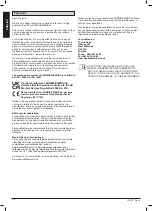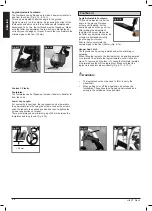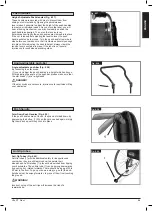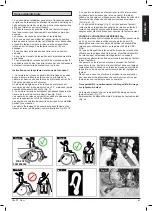
ENGLISH
26
Life RT Rev.J
Castor
Castor, Castor adapter, Castor
fork (Fig. 6.24)
From time to time the wheelchair
may veer slightly to the right or left
or the castors may flutter.
This may be caused by the
following:
• Forward and/or reverse wheel
motion has not been set properly.
• The castor angle has not been
adjusted properly.
• Castor and/or rear wheel air pressure is incorrect; wheels do not
turn smoothly.
The optimum adjustment of the castors is required so that the
wheelchair runs in a straight line. Castors should always be adjusted
by an authorized dealer.
The castor plates must be re-adjusted, and the wheel locks must be
checked every time the rear wheel position has been altered. Check
the setting of the castor adapter (1) by placing a set-square next to
it and looking at it from the front. Make sure that the adapter is at
right angles to the floor. By undoing the screws (2) and moving the
adapter, you can then re-adjust the wheels to their optimum position,
by adjusting the corresponding teeth segments. Make sure that after
any adjustment work, all screws are tightened correctly (see the
page on torque).
The screws used are fitted with threadlock at the factory and can
be adjusted up to 5 times after fitting. After that they should be
replaced or alternatively re-secured with threadlock to medium
tightness.
Fig. 6.24
90°
2
1
Axle plate
Axle plate
(Fig. 6.25)
The position of the centre of gravity in relation to the rear wheel
is an important factor for easy and comfortable driving. Several
positions are possible. If you move the perforated plate to the
rear (1) in the frame holes (2), the chair is in a safe position, but
at the same time is not so manoeuvrable, as it is when the
perforated plate is positioned further forward.
By moving the axle adapter (3) in the perforated plate, the seat
height of the chair can be adjusted. Make sure that after any
adjustment work, all screws are tightened correctly (see the
page on torque).
CAUTION!
If necessary, the brakes and castors must be re-adjusted.
Fig. 6.25
3
1
2
Cambers
Cambers
(Fig. 6.26 - 6.26.1)
The camber of the chair can be adjusted from 1° to 6°.
Doing this gives increased stability against the wheelchair falling
to the side, and will also improve the wheelchair’s
manoeuvrability.
Loosen the screws on the perforated plate (1). Then adjust the
adapter (2) to the desired angle setting. Then tighten the screws
again (see the page on torque).
Setting the wheel camber increases the overall width of the
wheelchair (each degree adds on approx. 1mm).
CAUTION
!
If necessary, the brakes and castors must be re-adjusted.
Fig. 6.26.1
1
2
Fig. 6.26
















































